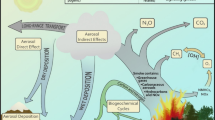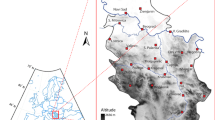Abstract
This study reveals the dynamics in the number and intensity of heat waves in Bulgaria in the late 20th and early twenty-first century, as well as their impact on forest fires in the beginning of this century. Statistical methods such as linear regression and Spearman’s correlation were the main tools of this study. Multiple linear regression models were used in order to reveal the complex influence of heat wave characteristics on forest fires in Bulgaria. Over the last four decades, there has been a statistically significant trend of increasing number of days belonging to heat waves. There is no significant trend (except in southwestern Bulgaria) in the average maximum temperatures of heat waves in the period 1979–2021. This is due to a change in the atmospheric circulation over Bulgaria in the twenty-first century toward increased transport of air masses from northeast in summer. The heat waves have a significant impact on the forest fires in Bulgaria in summer. In general, more, longer and having higher air temperatures heat waves provide more favorable conditions for the occurrence and development of forest fires. The results of this study can serve to build on the existing methodology for determining the risk of forest fires in the territory of Bulgaria, including factors such as the total duration and intensity of heat waves.












Similar content being viewed by others
References
Barbu N, Georgescu F, Ştefanescu V, Ştefan S (2014) Large-scale mechanisms responsible for heat waves occurrence in Romania. Rom J Phys 59(9–10):1109–1126
Burrows AT (1901) Hot waves. Yearbook U.S. Dept. of Agriculture for 1900, 8: 325–336.
Cardil A, Salis M, Spano D, Delogu G, Molina-Terren D (2014) Large wildland fires and extreme temperatures in Sardinia (Italy). iFOrest-Biogeosci for 7(3):162. https://doi.org/10.3832/ifor1090-007
Cardil A, Eastaugh CS, Molina DM (2015) Extreme temperature conditions and wildland fires in Spain. Theoret Appl Climatol 122(1):219–228. https://doi.org/10.1007/s00704-014-1295-8
Croitoru AE, Piticar A, Ciupertea AF, Roşca CF (2016) Changes in heat waves indices in Romania over the period 1961–2015. Global Planet Change 146:109–121. https://doi.org/10.1016/j.gloplacha.2016.08.016
Fire Detection (2020) INTERREG V-A Cooperation Programme GreeceBulgaria 20142020, https://www.fire-detection.eu/images/studies/Deliverable522_Fire_Risk_Assessment.pdf
Dimitrov T, Spasova Z (2019) Summer heat waves in Sofia and their impact on stroke and heart attacks. In: Scientific reports from the 12th scientific conference “Climate changes–a global threat for the food chain”, S., 41–60 (in Bulgarian).
EFA (2022) Executive Forest Agency Information System, http://www.iag.bg/lang/2/index
Copernicus Climate Change Service (C3S). 2017. ERA5: Fifth generation of ECMWF atmospheric reanalyses of the global climate. Copernicus Climate Change Service Climate Data Store (CDS). https://cds.climate.copernicus.eu/cdsapp#!/home
Freedman DA (2009) Statistical models: theory and practice. Cambridge University Press. https://doi.org/10.1017/CBO9780511815867
Gocheva A, Trifonova L, Marinova T, Bocheva L (2006) Extreme hot spells and heat waves on the territory of Bulgaria. Water Observation and Information System for Decision Support, 23–26.
Hartmann DL, Klein Tank AMG, Rusticucci M, Alexander LV, Brönnimann S, Charabi Y, Dentener FJ, Dlugokencky EJ, Easterling DR, Kaplan A, Soden BJ, Thorne PW, Wild M, Zhai PM (2013) Observations: Atmosphere and Surface. In: Climate Change 2013: The Physical Science Basis. Contribution of Working Group I to the Fifth Assessment Report of the Intergovernmental Panel on Climate Change [Stocker TF, Qin D,. Plattner G-K, Tignor M, Allen SK, Boschung J, Nauels A, Xia Y, Bex V, Midgley PM (eds.)]. Cambridge University Press, Cambridge, United Kingdom and New York, NY, USA.
Ivanova V (2017) Heat waves over Varna region and an opportunity for their forecasting. Varna Medical Forum 5:101–105 ((in Bulgarian))
Koutsias N, Xanthopoulos G, Founda D, Xystrakis F, Nioti F, Pleniou M, Mallinis G, Arianoutsou M (2013) On the relationships between forest fires and weather conditions in Greece from long-term national observations (1894–2010). Int J Wildland Fire 22(4):493–507. https://doi.org/10.1071/WF12003
Molina-Terrén DM, Cardil A (2016) Temperature determining larger wildland fires in NE Spain. Theoret Appl Climatol 125(1):295–302. https://doi.org/10.1007/s00704-015-1511-1
NIMH (2022) Fire Danger Forecast Related to Vegetation State, https://storm.cfd.meteo.bg/meteo7/en/forecasts/soilMoisture
Nojarov P (2019) Factors affecting air temperature in Bulgaria. Theoret Appl Climatol 137(1–2):571–586. https://doi.org/10.1007/s00704-018-2622-2
Nojarov P (2021) Impact of climate change on atmospheric circulation, wind characteristics and wave in the western part of the Black Sea. Nat Hazards 109:1073–1095. https://doi.org/10.1007/s11069-021-04869-5
NSI (2010) Regions, Districts and Municipalities in the Republic of Bulgaria, https://nsi.bg/sites/default/files/files/publications/REGIONS_2010.pdf
Parente J, Pereira MG, Amraoui M, Fischer EM (2018) Heat waves in Portugal: Current regime, changes in future climate and impacts on extreme wildfires. Sci Total Environ 631:534–549. https://doi.org/10.1016/j.scitotenv.2018.03.044
EEA Report (2017) Climate change, impacts and vulnerability in Europe 2016. An indicator-based report. No 1, Luxembourg, 300–302. https://doi.org/10.2800/534806
Sanderson MG, Economou T, Salmon KH, Jones SE (2017) Historical trends and variability in heat waves in the United Kingdom. Atmosphere 8(10):191. https://doi.org/10.3390/atmos8100191
Sfîcă L, Croitoru AE, Iordache I, Ciupertea AF (2017) Synoptic conditions generating heat waves and warm spells in Romania. Atmosphere 8(3):50. https://doi.org/10.3390/atmos8030050
Shevchenko O, Lee H, Snizhko S, Mayer H (2014) Long-term analysis of heat waves in Ukraine. Int J Climatol 34(5):1642–1650. https://doi.org/10.1002/joc.3792
Spasova Z, Dimitrov T (2017) The effect of heat waves on road accidents. Mech Transp Commun 15(3):1–7 ((in Bulgarian))
Tomczyk AM, Bednorz E (2016) Heat waves in central Europe and their circulation conditions. Int J Climatol 36(2):770–782. https://doi.org/10.1002/joc.4381
Tomczyk AM, Sulikowska A (2018) Heat waves in lowland Germany and their circulation-related conditions. Meteorol Atmos Phys 130(5):499–515. https://doi.org/10.1007/s00703-017-0549-2
Tomczyk AM, Półrolniczak M, Bednorz E (2017) Circulation conditions’ effect on the occurrence of heat waves in western and southwestern Europe. Atmosphere 8(2):31. https://doi.org/10.3390/atmos8020031
Unal YS, Tan E, Mentes SS (2013) Summer heat waves over western Turkey between 1965 and 2006. Theoret Appl Climatol 112(1):339–350. https://doi.org/10.1007/s00704-012-0704-0
Unkašević M, Tošić I (2011) The maximum temperatures and heat waves in Serbia during the summer of 2007. Clim Change 108(1):207–223. https://doi.org/10.1007/s10584-010-0006-4
Unkašević M, Tošić I (2015) Seasonal analysis of cold and heat waves in Serbia during the period 1949–2012. Theoret Appl Climatol 120(1):29–40. https://doi.org/10.1007/s00704-014-1154-7
Vanderplanken K, van den Hazel P, Marx M, Shams AZ, Guha-Sapir D, van Loenhout J (2021) Governing heat waves in Europe: comparing health policy and practices to better understand roles, responsibilities and collaboration. Health Res Policy Syst 19(1):1–14. https://doi.org/10.1186/s12961-020-00645-2
Wibig J (2018) Heat waves in Poland in the period 1951–2015: trends, patterns and driving factors. Meteorology hydrology and water management. Res Op Appl 6(1):1–9
Wibig J (2021) Hot Days and heat waves in Poland in the period 1951–2019 and the circulation factors favoring the most extreme of them. Atmosphere 12(3):340. https://doi.org/10.3390/atmos12030340
Wilks DS (2006) Statistical Methods in the Atmospheric Sciences, Volume 91, Second Edition (International Geophysics), Elsevier, Academic Press, p. 627
Xu P, Wang L, Liu Y, Chen W, Huang P (2020) The record-breaking heat wave of June 2019 in central Europe. Atmos Sci Lett 21(4):e964. https://doi.org/10.1002/asl.964
Zschenderlein P, Fink AH, Pfahl S, Wernli H (2019) Processes determining heat waves across different European climates. Q J R Meteorol Soc 145(724):2973–2989. https://doi.org/10.1002/qj.3599
Zumbrunnen T, Menéndez P, Bugmann H, Conedera M, Gimmi U, Bürgi M (2012) Human impacts on fire occurrence: a case study of hundred years of forest fires in a dry alpine valley in Switzerland. Reg Environ Change 12(4):935–949. https://doi.org/10.1007/S10113-012-0307-4
Funding
This work has been carried out in the framework of the National Science Program “Environmental Protection and Reduction of Risks of Adverse Events and Natural Disasters,” approved by the Resolution of the Council of Ministers № 577/17.08.2018 and supported by the Ministry of Education and Science (MES) of Bulgaria (Agreement № Д01-363/17.12.2020).
Author information
Authors and Affiliations
Contributions
All authors contributed to the study conception and design. Material preparation, data collection and analysis were performed by Peter Nojarov and Mariyana Nikolova. The first draft of the manuscript was written by Peter Nojarov and Mariyana Nikolova. All authors read and approved the final manuscript.
Corresponding author
Ethics declarations
Conflict of interest
The authors have no relevant financial or non-financial interests to disclose.
Ethical approval
Ethical approval is not applicable for this article. This article does not contain any studies with human or animal subjects. There are no human subjects in this article, and informed consent is not applicable.
Additional information
Publisher's Note
Springer Nature remains neutral with regard to jurisdictional claims in published maps and institutional affiliations.
Rights and permissions
About this article
Cite this article
Nojarov, P., Nikolova, M. Heat waves and forest fires in Bulgaria. Nat Hazards 114, 1879–1899 (2022). https://doi.org/10.1007/s11069-022-05451-3
Received:
Accepted:
Published:
Issue Date:
DOI: https://doi.org/10.1007/s11069-022-05451-3




